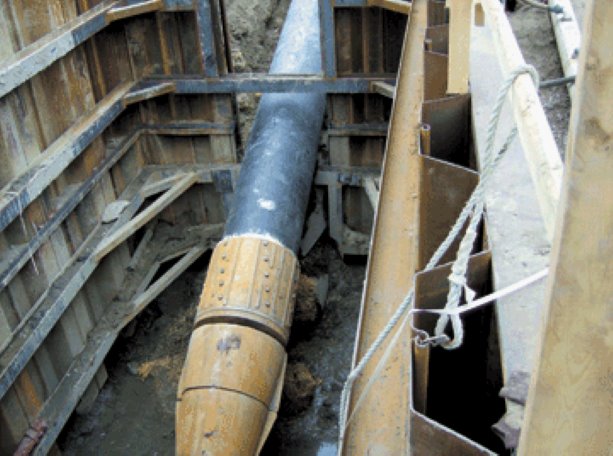It’s likely the first example of the use of large-scale pipe bursting trenchless technology in Canada. The City of Windsor, Ontario has completed installation of 1,150 linear metres of 880-millimetre-wide HDPE (high-density polyethylene) pipe along the busy Ojibway Parkway in the city’s industrial west end, a route which is also a major commuting thoroughfare to Windsor’s southern suburbs.
The four-lane highway also happens to be located in a narrow utility corridor and on soil that has high water density.
Suffice it to say that all were factors in the city’s engineering department deciding to put the tender out for an unconventional trenchless excavation bid.
■ Daily Commercial News subscribers may view more information on SLR Contracting Group and its construction projects by viewing company ID 844127 in Reed Construction Data Canada Building Reports.
If you are not already a subscriber, you can be by filling out the form at this web page.
Building Reports are published daily in the Daily Commercial News. The Daily Top 10 Construction projects can be viewed online free of charge at the Reed Construction Data Canada Building Reports web page.
To learn more about construction project leads from Reed Construction Data, fill out the web form at this web page.
City engineer Fahd Mikhael said that several years ago the city had requested bidding for an open-cut excavation at the site but received no takers. Open cut would have been a prolonged and difficult process, requiring immense dewatering and utility relocation, then repaving the highway and might have consumed half a year in time.
With the re-jigged trenchless tender, Windsor-based SLR Contracting Group Inc. stepped up to the plate. SLR, a 2010 amalgam of three companies with extensive sewer and watermain experience, agreed to add more expertise to its knowledge base and learn the pipe bursting method, typically used in smaller water line or individual residential projects.
SLR project engineer and senior estimator Rob DiMenna said the company worked with U.S. manufacturer MidWest Trenchless Services of Grant, Mich. which built the 900-mm diameter “bursting head” tool specifically for the project.
“We did some homework and felt confident enough in our tender,” he said.
The manufacturer provided training and its staff were on hand for the project’s duration. That began March 12 and wrapped up — including accounting for a two week city-wide construction strike — June 15.
“Obviously it was quite a challenging project,” DiMenna said. “It was intimidating to some people.”
Using trenchless technology provided an advantage in that the city had to close just one southbound road lane. It also meant all the utilities could be kept in place.
It was also substantially cheaper coming in at $3,795,000. Mikhael couldn’t suggest what an open-cut tender would have cost but estimates elsewhere put the general difference at between 20 and 40 per cent.
DiMenna said factors like the number of laterals coming off the pipe, such as in a residential area, add to the cost. But this project was “basically a service line” with no laterals.
Unlike traditional open cut, trenchless technology only requires limited excavation with trench boxes placed in regular intervals, in this case every 170 metres along the 1.2 kilometre corridor. SLR designed the 24 by 12 ft. boxes to fit the tight spaces. These are where the pipe bursting tool head was inserted into the almost 100-year old concrete pipe, breaking it apart and pulling the new HDPE pipe through. DiMenna said 170 metres of fused-on-site HDPE pipe was the longest length that could be pulled. The box was designed to handle machine forces and for job safety.
DiMenna said using trenchless technology in soil that amounted to “liquid sand” made all the difference, requiring only localized dewatering for the excavated pits.
It took roughly 12 hours to pull 170 metres of HDPE pipe.
“It went well but there are a lot of forces on the pipe as you burst,” DiMenna said.
That’s because the broken concrete slides back down on the HDPE pipe which replaces it.
“So you get a lot of drag force in there,” he said.
There are various types of pipe-bursting steel tool heads but this one was a static and pneumatic combo. Static bursts the pipe simply by its own force.
But the head was designed to have pneumatic air shot in to trigger a hammer for denser work such as when encountering a manhole with thicker walls and bench bottoms.
“So they can hit it with a 350 CFM compressor, it almost doubles the actual force,” providing 500 tons of pulling power versus the typical 330 tons, DiMenna said.
Besides the issue with the water-caked soil and high water table, the corridor was “very congested,” DiMenna said.
“We had a 500 pair Bell cable that was right beside us, we had a 24 -inch high pressure concrete watermain that was right beside our trench, we had hydro poles that were right on top of this pipe,” he said. Not to mention mature trees that lined the route.
The poles necessitated the city calling in a couple of Hydro One trucks to actually grip the poles while the pipe was being pulled through underneath.




Recent Comments
comments for this post are closed